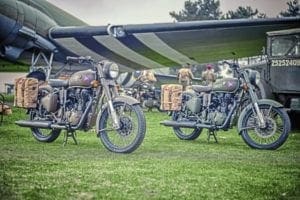I’m sure you know this already, but Royal Enfield, the world’s oldest motorcycle manufacturer, has a long, long history of working with the British armed forces.
Back in the late (very late!) 1800s, the Eadie Manufacturing Company Limited, who’d taken over the Townsend and Ecossais pedal-cycle business, launched in 1886, won contracts to supply precision parts for firearms to the government’s long-established Royal Small Arms Factory at Enfield, Middlesex, and assumed the brand name Royal Enfield. In 1901, they diversified into motorcycles, two years before Harley-Davidson, and continued to produce munitions, artillery equipment and motorcycles during both World Wars, and still supplies the Indian Armed Forces with bikes to the present day. Known for their ruggedness, Royal Enfields served with British troops in France and Belgium during the First World War, and were supplied to the Imperial Russian Army.

Enjoy more Back Street Heros reading in the monthly magazine.
Click here to subscribe & save.
Their most famous wartime creation was for the airborne troops in the Second World War; the ‘Flying Flea’ was a compact and capable, two-stroke 125cc that saw action in some of the greatest battles of this war, including D-Day and Arnhem. During the war, tens of thousands of Royal Enfields were shipped to almost every theatre of conflict, but the Flea was the only proper motorcycle to be dropped successfully behind enemy lines with paratroopers, and the War Department ordered more than 4,000.

Simple, tough and resilient, the WD/RE, to use its official title, was deployed extensively as a front-line combat machine. An invaluable asset to the elite soldiers of the newly formed Parachute Regiment, it was dropped by parachute in a protective steel cradle or carried in Horsa assault gliders, and on the ground, it was used for reconnaissance, communications and carrying soldiers into battle. It proved itself in September 1944’s Operation Market Garden, the largest airborne operation in history; a daring Allied attempt to shorten the war by entering Germany from Holland over a series of captured bridges, it culminated in the Battle of Arnhem where besieged and outnumbered paratroopers held out against German tank divisions for seven days in an incredible show of grit and determination. Beset with problems including broken radio sets, commanders relied on the Flea to carry messages – its strength and go-anywhere handling made it almost unstoppable; confronted with a fence or a ditch, the rider could simply dismount and lift the bike over.

The Flying Flea played a different, but just as vital, role on D-Day, the largest amphibious invasion in history – as the Allies fought to establish a beachhead in Normandy, Northern France, in preparation for the invasion of German-occupied Western Europe, hundreds of Flying Fleas and James ML motorcycles streamed from landing craft on to the beaches. The ramp would touch down and out would come the motorcycles; they were used as a means of rounding up troops and getting them forward, and also accompanying troops much as a convoy escort rider would have done. D-Day’s commanding officers later praised the lightweight motorcycles and their riders, known as ‘beachmasters’, for their part in the landings’ success.




